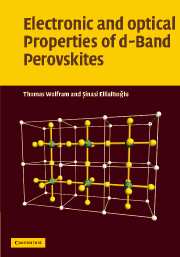Book contents
- Frontmatter
- Contents
- Preface
- 1 Introductory discussion of the perovskites
- 2 Review of the quantum mechanics of N-electron systems
- 3 Empirical LCAO model
- 4 LCAO energy band model for cubic perovskites
- 5 Analysis of bands at symmetry points
- 6 Density of states
- 7 Optical properties of the d-band perovskites
- 8 Photoemission from perovskites
- 9 Surface states on d-band perovskites
- 10 Distorted perovskites
- 11 High-temperature superconductors
- Appendices
- Index
10 - Distorted perovskites
Published online by Cambridge University Press: 23 December 2009
- Frontmatter
- Contents
- Preface
- 1 Introductory discussion of the perovskites
- 2 Review of the quantum mechanics of N-electron systems
- 3 Empirical LCAO model
- 4 LCAO energy band model for cubic perovskites
- 5 Analysis of bands at symmetry points
- 6 Density of states
- 7 Optical properties of the d-band perovskites
- 8 Photoemission from perovskites
- 9 Surface states on d-band perovskites
- 10 Distorted perovskites
- 11 High-temperature superconductors
- Appendices
- Index
Summary
The majority of perovskites are not cubic, but many of the non-cubic structures can be derived from the cubic (aristotype) structure by small changes in the ion positions. Several types of distortions occur among the perovskites. The most important types are those involving (a) ion displacements in which, for example, the B ion or A ion (or both) moves off its site of symmetry; (b) rotations or tilting of the BO6 octahedra; and (c) both tilting and displacements.
Departure from the cubic perovskite structure will occur whenever distortions lead to a lower total energy. The lowering of the total energy in most cases is small, typically of the order of a tenth of an eV/cell and dependent upon the temperature. The additional stabilization energy of one structure over another depends in a subtle manner upon the competition between a number of electronic factors including changes in the Coulomb interactions (Madelung potentials), changes in the degree of covalent bonding, and the number of electrons occupying the antibonding conduction bands. In many cases changes in the A–O covalent bonding is thought to play a key role in determining the distorted structure.
Clearly it is not possible to predict structures based on the simple LCAO model we have been studying. However, given a particular structure that is close to the cubic structure one can examine the changes in the electronic states with the goal of understanding why the distorted structure is more stable.
- Type
- Chapter
- Information
- Electronic and Optical Properties of d-Band Perovskites , pp. 231 - 248Publisher: Cambridge University PressPrint publication year: 2006

